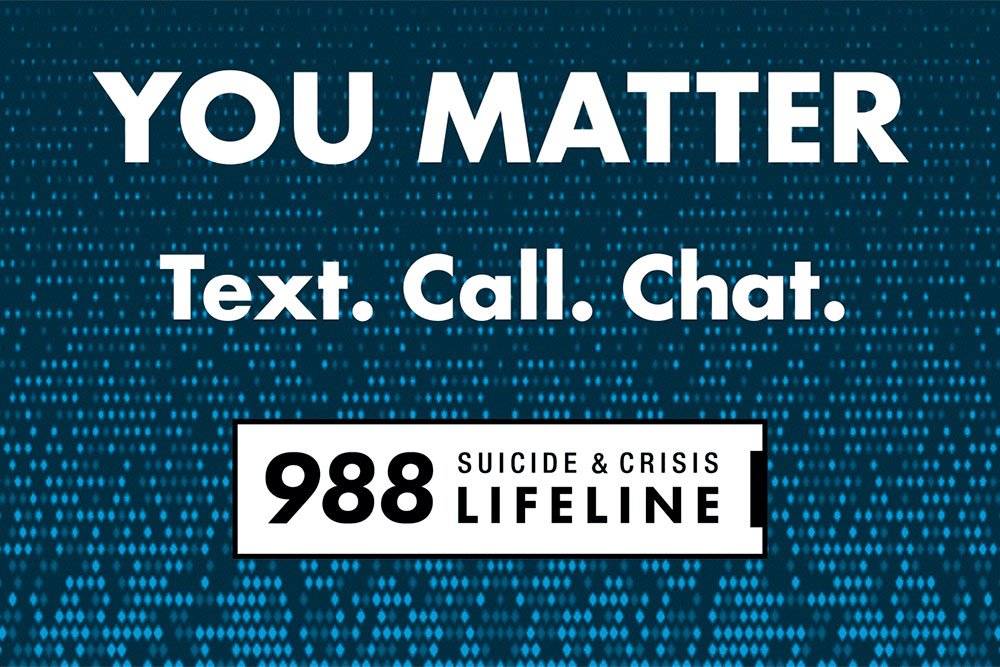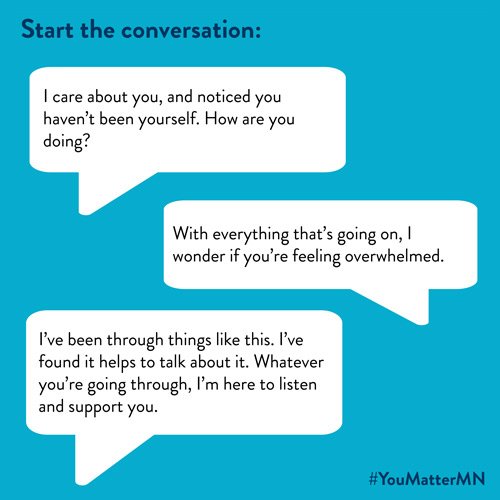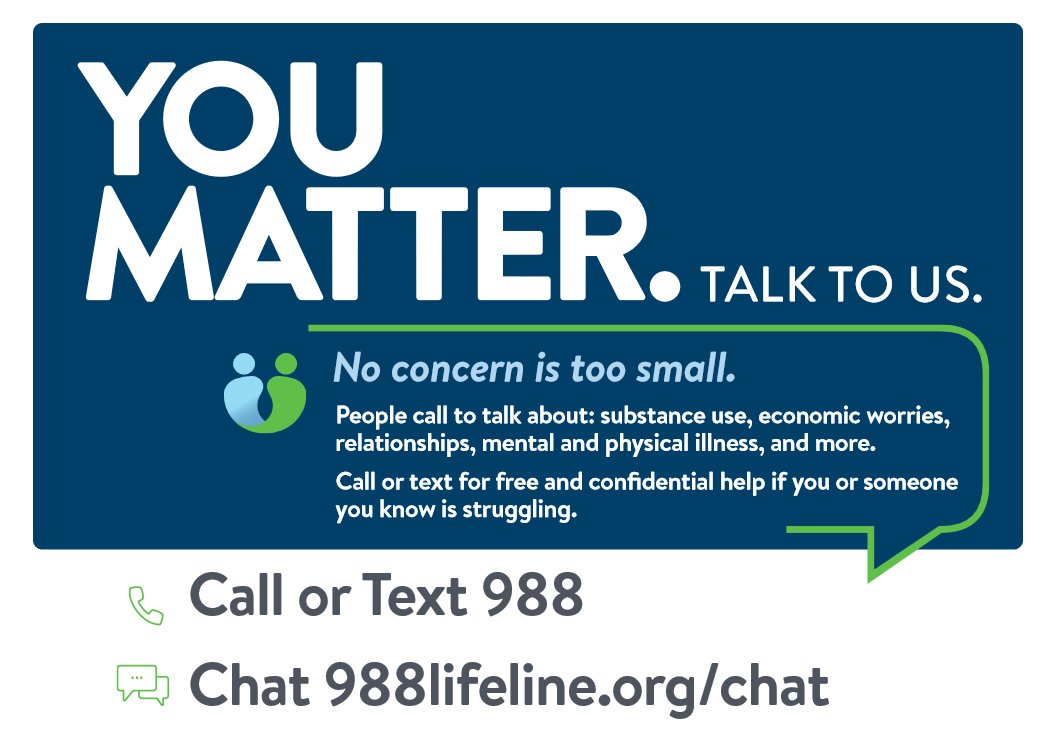Take the Connection Challenge for Suicide Prevention Awareness Month
 September is Suicide Prevention Awareness Month. Although mental health and suicide prevention is important to address year-round, Suicide Prevention Awareness Month dedicates time for people, organizations and communities to share that there is hope, help is available and healing is possible.
September is Suicide Prevention Awareness Month. Although mental health and suicide prevention is important to address year-round, Suicide Prevention Awareness Month dedicates time for people, organizations and communities to share that there is hope, help is available and healing is possible.
Suicidal thinking is much more common than most people know. The National Institute of Health estimates that around 15 million people have serious thoughts of suicide every year. In 2021, over 48,000 Americans died by suicide, and about 1.7 million people attempted suicide. We know from people who share their suicidal experiences with researchers, that people often feel very alone when they begin having suicidal thoughts. We also know that for many people, connection and hope are the two most vital protective factors that prevent people from acting on their suicidal thoughts. Connection decreases isolation and encourages healthy coping behaviors. Connection can be found within oneself, within relationships and within the community.
If you are having any struggles in your own life, these key connections may help support you through these difficult times. If things are going well for you right now, we encourage you to keep reading and focus on ways you can connect with others. It will continue to support your own resiliency long-term, and you never know if someone else you connect with may be at risk of suicide. Your connection may be a vital link to their safety.
The Minnesota Department of Health created a four-week Connection Challenge.
Week 1: Connection for Ourselves
 Connection is not just nice to have, it is essential to one's health and well-being. People with meaningful social connections have:
Connection is not just nice to have, it is essential to one's health and well-being. People with meaningful social connections have:
- Less stress and better sleep
- Better overall health that can lead to a longer life
- Healthier habits and behaviors
- Better quality of life and sense of belonging
Connecting can be as deep as a heart-to-heart conversation or as simple as sharing a smile with someone. Meaningful connections can come from people in any role in your life, such as a neighbor, friend, family member, co-worker or community member. Connection can look like someone willing to help you with a task, or someone to listen and validate your feelings. Or perhaps, it is someone who can give you a different perspective than your own or provide advice or support for something that you are struggling with.
There are things you can do to form new connections. While there are no official guidelines, and no one-size-fits-all, below are some suggestions for finding and fostering connections with others:
- Start a conversation. Talk to people who you already have connections with and build upon that relationship or take an opportunity to authentically get to know your neighbors and co-workers that you just wave at or say hi to in passing.
- Join a club or enroll in a class that intrigues you. You'll know the people who will be there already share a common interest with you. If you end up not meeting anyone new, you will still get to do something that you enjoy.
- Get involved in your community by attending events and doing things that you have not tried before.
- Explore opportunities to serve and help others within your community. Many organizations, including faith-based organizations offer volunteer opportunities that can give you the chance to contribute to something that you find important.
- Create a larger and more diverse social network. Having a variety of relationships will allow you to gather additional resources, information and opportunities.
- Don't let technology distract you from engaging with people. Pay attention to ways it may make you feel worse about yourself or others. Use technology as a tool to make positive and intentional connections.
Week 2 – Connecting With Loved Ones
 If someone you know is struggling emotionally or having a hard time, connecting with them can be the difference in getting them the help they need. Talking to a loved one about mental health and suicide can be an uncomfortable and uncertain topic, but it is also one of the best ways to prevent it. We can all take action to have these conversations with someone who may be suicidal by using the five action steps from #BeThe1To.
If someone you know is struggling emotionally or having a hard time, connecting with them can be the difference in getting them the help they need. Talking to a loved one about mental health and suicide can be an uncomfortable and uncertain topic, but it is also one of the best ways to prevent it. We can all take action to have these conversations with someone who may be suicidal by using the five action steps from #BeThe1To.
Ask
- Asking "Are you thinking about suicide?" shows that you are willing to discuss suicide in a nonjudgmental and supportive manner. The other important part of this step is to listen to their reasons for their emotional pain as well as the reasons that they want to continue to live. Help them focus on their reasons for living, not on the reasons you think that they should stay alive.
- Findings suggest that acknowledging and talking about suicide may reduce suicidal ideation.
Be There
- Be physically present for someone, speak with them on the phone when you can, or show up in any other way that demonstrates support for the person at risk. If you are unwilling or unable to commit to being there, talk with them to develop ideas on who might else be able to help.
- Increasing someone's connectedness to others and limiting their isolation has shown to be a protective factor against suicide.
Help Keep Them Safe
- After the "Ask" step, and you've determined suicide is indeed being talked about, it is important to find out a few things to establish immediate safety. The first question will be to ensure that they have not done something already to hurt themselves. Secondly, you will want to ask them if they have a plan and a way to die by suicide.
- Knowing the answers to each of these questions can tell us about the imminence and severity of danger the person is in.
- You can call or text the 988 Suicide & Crisis Lifeline to support you and the person you care about to make decisions about safety and the next steps to provide support.
Help Them Connect
- One way to start helping them find ways to connect is to work with them to develop a safety plan. A safety plan is designed to guide people through a crisis, with a goal to keep them safe and get them help.
- Connected people are significantly less likely to feel depressed, suicidal and overwhelmed, while also feeling more hopeful.
Follow Up
Make sure to follow up with them to see how they're doing. Leave a message, send a text or give them a call. This is a great time to see if there is anything else that you can do to support them.
This type of contact can continue to increase their feelings of connectedness and share your ongoing support. There is evidence that even a simple form of reaching out, like sending a caring postcard, can potentially reduce their risk of suicide.
Please visit Suicide Prevention for more resources related to mental health and suicide prevention. For additional support to build personal resiliency, check out the Bounce Back Project.
Learn about Connecting with Community and Connection to Hope and Healing in my next blog post.
